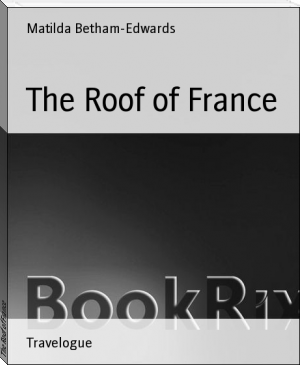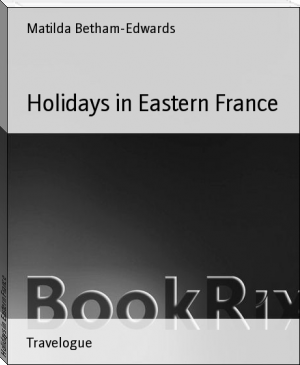The Roof of France by Matilda Betham-Edwards (which ebook reader TXT) 📕

- Author: Matilda Betham-Edwards
Book online «The Roof of France by Matilda Betham-Edwards (which ebook reader TXT) 📕». Author Matilda Betham-Edwards
Far away the famous Mont Beuvray, the Bibracte of the 'Commentaries' lying half-way between Chateau-Chinon and Autun, is a bold, grand outline to day, under a cold, gray sky. Wild crags to climb and romantic sites abound, also scenes of quiet caressing grace and smiling pastoralness. Nowhere can be found more beautiful pastures, winding lanes, tossing streams. The country round about is wonderfully solitary, but newly-built schools in the scattered villages tell of progress.
Meantime driver and passengers alight whilst our steady horses climb one sharp ascent after another. As we wind about the hills we catch sight of tiny hamlets perched on airy crests, recalling the castellated villages of the African Kabylia.
Arrived at our destination, the ancient capital and stronghold of the Celtic Morvan, the whole country lies at our feet as a map--sunny pasture and cornland, glen and dale, mountain stream, tumbling river and glittering cascade, alternating with sterner and grander features-- dark forests covering vast spaces, rugged peaks towering aloft, wild sweeps of heather-covered moorland. Seen as I saw this region, under a wind-tossed lowering heaven, the impression was of extreme desolation and wildness; only a glimpse of sunshine was needed to bring out the witchery of each shifting scene. Nothing can be prettier in a quiet way than these countless rivers and rivulets, each fringed with lofty alders, these velvety glades and winding lanes. Forests abound, and I was assured by a peasant that the poor never need buy any firewood. They can pick up enough to last them all winter.
Immediately below Chateau-Chinon opens a fair valley, threaded by the river Yonne. Bewildering is the sense of space and atmosphere we obtain here, as we look straight down into the clifts below, or allow the eye to wander over the vast panorama stretching around.
A town perched on a height two thousand feet above the sea-level, so placed as to command an entire kingdom, should have a history, and the history of Chateau-Chinon goes very far back indeed. The fortified citadel of the seigneury was built on the site of a Gallo-Roman camp, or castrum, the castrum on that of a Gallic oppidum. The once warlike, grim little place, that often defied its enemies in the seigneurial wars, is now the most dead-alive, sleepy little provincial place imaginable.
'We will breakfast together,' said the gray-haired conductor of the diligence to me; 'and you will afterwards have time to look round before we start home.'
Although pure Celts, the Morvandiaux have not the proud reserve and, perhaps, distrust of strangers found among the Bretons. I have driven for miles across country alone with a Breton peasant, and he would never once open his lips. Had I carried bags of gold about me, I should have been perfectly safe under such protection. But a sociable invitation to chat over the ordinary of an auberge would never have entered the head of a diligence-driver in the Morbihan or Finistere.
The little inn looked temptingly rustic and primitive, and the smiling, round-faced, rosy-cheeked landlady might have just walked out of a picture. Exactly such a landlady I remember at Llangollen years ago.
I had, however, no time to stay, and we drove v back to Autun, making the descent at a rapid rate, catching by the way the glimpse of a stately peasant, with the Gallic saie, or mantle, thrown over his shoulders. He might have sat for a study of Vercingetorix! It was worth while going to Chateau-Chinon for the sight of such a piece of antiquity as that!
Alas! Chateau-Chinon is to have a railway, and alike the mantle worn by Vercingetorix and his countrymen, the ancient Gallic speech--even the time-honoured system of log-floating--are doomed. Instead of being invited to breakfast with the blue-bloused pleasant driver of the diligence, I shall expect to find at table-d'hote half a score of English undergraduates, members of the bicyclist club, or a party of enterprising ladies from Chicago.
A word about Autun itself, a town that improves marvellously on acquaintance. This was my third visit, and I found it more attractive than ever. The beauty of its site is best appreciated from the lower ground beyond its western suburb. And beautiful it is--the graceful cathedral, with its airy spire and twin towers, pencilled in soft, silvery gray against the dimpled green hills, every feature of the landscape in harmony with it, as if, indeed, made to be in harmony with it. Turning from the cathedral in an opposite direction, in order to make the circuit of the city, we realize how grand was the predecessor of modern Autun the Augustodonum of Gallic Rome. Keeping to this higher ground, we can follow with the eye the tremendous span of the Roman wall, fragmentary for the most part, yet perfect in places, and built neither of bricks nor blocks of stone, but of small stones.
Inside the enclosure we see the mediaeval wall and picturesque watch- towers of the French king Francis. Picturesque as these are--also the bits of ordinary domestic architecture between airily-perched dormers, stone balconies filled with flowers, little terraced gardens rising one above the other-the mind is too much occupied with the grand Roman aspect of the place to dwell as yet upon minor points. The circuit of the city, so made as to visit its two magnificent Roman gateways, and equally fine so-called Temple of Janus, is beyond the reach of moderate walkers. All are noble specimens of Augustan architecture, more especially the Porte d'Arroux. This stands on the north side of the town, beyond the suburbs, its lofty arches spanning the road, and wearing, from the distance, the look of an aqueduct. It is built of huge blocks of stone adjusted without cement. Between the upper tiers of arches are sculptured Corinthian columns, all happily uninjured. So massive is this structure, so firmly it stands, that we feel as if, like the Pyramids, it might last for ever.
Beyond, on either side, stretches the pleasant open country-fields and meadows and market-gardens; whilst far away, in bright sunny weather looking like a violet cloud, is the vast height of Bibracte, so celebrated in the 'Commentaries.'
But the most curious monument at Autun is the so-called Pierre de Couhard. From all parts of the city may be seen, rising conspicuously from its green eminence, this stately relic-maybe of Roman or Gallic times, perhaps raised of remoter date still--a vast pyramid of stone, worthy to be compared to the great tomb of Caius Sextius in Rome.
It is a pleasant walk to what the townsfolk call the Pierre de Quare. Leaving behind us the cathedral and suburbs, we follow a road winding in a south-easterly direction to the little village of Couhard, watered by a gurgling stream, and sheltered by a fair green hill. As we quit the highroad to reach the monument, we come upon pretty pastoral groups. It is supper-time-l'heure de la soupe, as French rustics say-- and before every cottage-door are squatted family groups, eating their pottage on the doorsteps. Around are the dogs and cats, chickens, pigs and goats. To every humble homestead is attached orchard, garden, even a patch of corn or vineyard. All is peace and contentment.
Certainly these rural interiors would not satisfy everybody. Neatness and cleanliness do not always prevail among poor folks in France, any more than in England. But, alike, young and old are neatly and wholesomely dressed. Beggars are almost nil, and the prevailing aspect is one of unforgettable well-being, independence, and cheerfulness.
In strange contrast with these domestic pictures--pet kittens and children playing close under its shadow, tiny cabbage and tomato beds planted to its very edge-stands the huge, angular, pyramidal pile called the Pierre de Quare.
Very striking is the effect of the huge, solid brown mass, tapering to a point, from summit to base reaching half the height of the cathedral- spire, its original height in all probability having been much loftier.
The whole is a ruin, yet intact, if I may be pardoned the paradox. Whilst the inner part of the monument remains uninjured, its sides have been stripped of the marble slabs or polished stones that once in all probability covered and adorned them. The outer surface now shows a rough, jagged ensemble of masses of stone rudely put together, the entire pyramid being solid.
We walked home in the evening light, getting dozens of charming pictures in the twilight--pictures already familiar to me, yet ever bringing a sense of newness. French towns, like French scenery, should be revisited thus, and I hope ere very long to pay Autun my fourth visit, and to take, for a second time, those delightful drives from Avallon to Vezelay, and from the modern capital of the little Celtic kingdom to the ancient, perched so airily above the surrounding hills.
CHAPTER III. FROM LYONS TO AVIGNON BY THE RHONE.
From Autun to Lyons is a journey that calls for little comment, unless made, as wise Arthur Young made it a hundred years ago, on horseback; or unless we take the steamer at Chalon, and enjoy the scenery of the Saone, Mr. Hamerton's favourite river.
We were too impatient, however, to reach the Causses to stop, even for the sake of a sail on the Saone, and made haste to catch the very next Gladiateur bound to Avignon. Why all these Rhone steamers should be called Gladiateur I don't know, but so it is.
By half-past five this bright August day we are on the deck of the little steamer, to find a scene of indescribable liveliness and bustle. All kinds of merchandise were being stowed away--bedding, fruit, bicycles, bird-cages, passengers' luggage, cases, and packages of every imaginable description.
A stream of peasants poured in, bound for various stations on the way, all heavily laden, some accompanied by their pet dogs. First-class passengers were not numerous. We had an elderly bridegroom, who might have been a small innkeeper, with his youthful bride, evidently making a cheap wedding-trip; a family party or two; an excitable man with a sick wife; a couple of pretty girls with two or three youths--brothers or cousins; a sprinkling of priests and nuns--that was all. The peasants with their baskets and bundles, at the other end of the vessel, made picturesque groups, and the whole scene was as French as French could be.
I was just thinking how pleasant it was thus to escape the routine of travel, to find one's self in a purely foreign atmosphere, among French people, picking up by the way French habits and ways of thought, when one of the officials of the company bustled up to me.
'Pray pardon me, madame,' he said, bringing out a note-book. 'I see that you are English. Will you be so very kind as to give me the name and address of the great tourist agency in London? We are organizing an entirely new service between Lyons and Avignon; we are going to make our steamers attractive to tourists. You will oblige us extremely by giving a little information.'
Crestfallen and with a sinking of the heart, I took his pencil--I could, of course, not do otherwise--and wrote in big letters:





Comments (0)